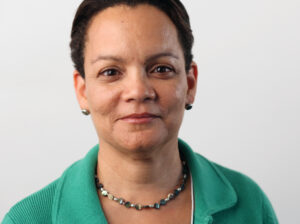By Ruth Santiago, lawyer and environmental health advocate
Hurricane season is well underway and people in Puerto Rico are very worried. Parts of the archipelago have yet to recover from hurricane Maria.
The widespread and prolonged power outage that left medical equipment inoperable after Hurricane Maria led to many more deaths than the hurricane itself.
Dirty fossil fuel plants provide 97% of Puerto Rico’s electricity, and most of the energy is generated in large plants along the south coast. I’ve seen the power grid fail after every hurricane.
Electricity lines need to move power largely from south to north, through the Central Mountain Range and forests. These lines are in the path of most hurricanes that strike Puerto Rico. Like Christmas lights, if there’s a problem anywhere along the line, the whole thing fails.

Since LUMA Energy, a new company created by Quanta Services and ATCO-Canadian Utilities, took over operation of the electric grid, power outages have gotten worse.
The Federal Emergency Management Agency (FEMA) allocated $9.6 billion for Puerto Rico’s electricity system and the government of Puerto Rico wants to rebuild the same grid that has failed us time and time again.
FEMA will soon decide whether to make that mistake or instead invest in better alternatives. Solar panels can be installed on rooftops across the island, bringing sources of power right to where people use it so that no one is dependent on unreliable long-distance lines. The only people I know who didn’t lose power during hurricane Maria were those with solar, which is why I installed it on my own roof.
It would be very disappointing for a disaster relief agency to lock us into decades more of the same dirty energy responsible for the climate crisis that intensifies the hurricanes thrashing Puerto Rico. Solar would help President Biden fulfill his climate goals by slashing Puerto Rico’s carbon dioxide emissions by 70% and be the epitome of what his Build Back Better plan strives to do.
The fossil fuel power plants in Puerto Rico are poisoning communities near them. The toxic coal ash waste from the AES plant in Guayama has poisoned the South Coast aquifer, the sole source of drinking water for tens of thousands of people. Residents of southeast Puerto Rico, including those in Guayama, Salinas, and other communities plagued by fossil plants, have among the highest rates of cancer and respiratory disease on the Island.
A coalition of community groups, labor, economists, engineers and environmental organizations created a proposal called Queremos Sol (“We Want Sun”), backed by a study, that found that the energy needs of 75 percent of the island’s energy and 100% of homes can be powered by rooftop solar paired with battery storage by 2035.
The definition of insanity is to do the same thing again and again expecting a different result. Puerto Rico’s expensive, dirty, and unreliable electric grid didn’t work before Maria, so why rebuild the same broken system? It’s time to finally build a power system that can survive the next hurricane, provide affordable electricity, and stop poisoning our people and environment. FEMA should give Puerto Rico life-saving rooftop solar and energy storage.
Ruth Santiago is a lawyer and environmental health advocate who lives in Salinas, Puerto Rico. She has represented nonprofit organizations and community groups in a wide array of practice areas including energy law, aquifer protections, and civil litigation in her legal career spanning over 30 years. Santiago is a White House Environmental Justice Advisory Council member and sits on Earthjustice’s Board of Trustees.
“The Invading Sea” is the opinion arm of the Florida Climate Reporting Network, a collaborative of news organizations across the state focusing on the threats posed by the warming climate.


